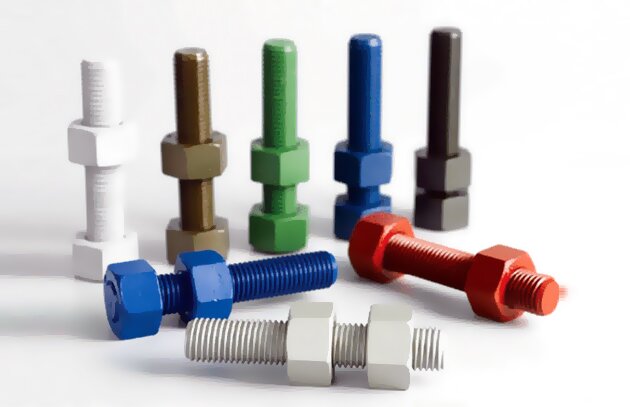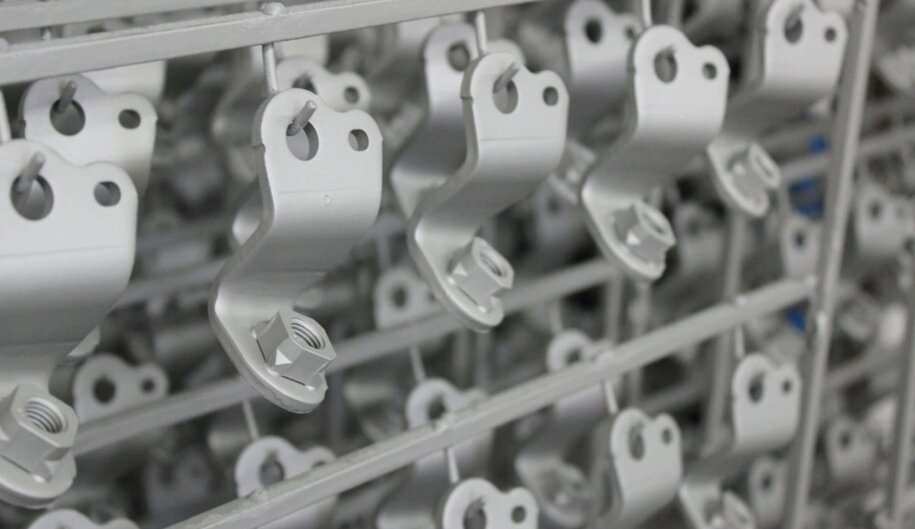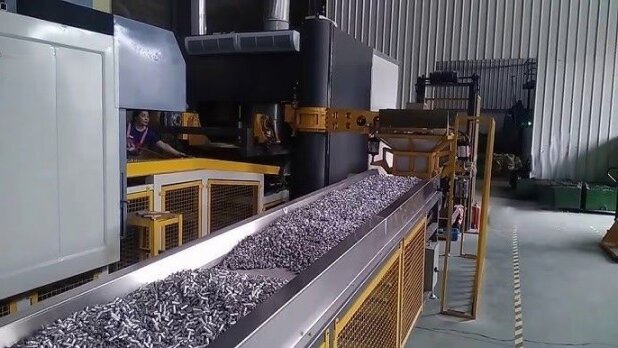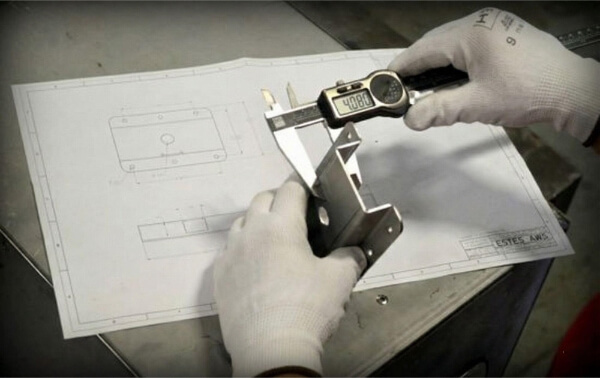تواجه الأجزاء المعدنية تهديدات مستمرة من الصدأ والتآكل، مما يؤدي إلى عمليات استبدال وصيانة مكلفة. وغالبًا ما تقصر الطلاءات الواقية التقليدية عن أداء وظيفتها، حيث تتآكل بسرعة أو لا توفر تغطية كافية. يعمل طلاء Dacromet على حل هذه التحديات من خلال تركيبته الفريدة من الزنك والألومنيوم، مما يوفر حماية فائقة في مختلف التطبيقات الصناعية.
هل تريد أن تتعلم كيف يمكن لتقنية الطلاء المتقدمة هذه أن تطيل عمر القطع لديك وتخفض تكاليف الصيانة على المدى الطويل؟ دعنا نتعرف على التفاصيل الفنية والفوائد وأفضل استخدامات طلاء Dacromet.

ما هو طلاء داكروميت؟
يجمع طلاء Dacromet بين رقائق الزنك ومسحوق الألومنيوم والمركبات غير العضوية في محلول مائي. يشكل نظام الطلاء المتطور هذا حاجزًا متعدد الطبقات من خلال عملية تطبيق دقيقة بالغمس متبوعة بالمعالجة بدرجة حرارة عالية.
فكّر في الأمر على أنه بناء درع للأسطح المعدنية - ولكنه أكثر ذكاءً من الطلاءات التقليدية. تبدأ العملية بغمس الأجزاء في خليط الطلاء ثم تدويرها لضمان تغطية متساوية ثم معالجتها عند حوالي 300 درجة مئوية. وهذا يخلق طبقة واقية بسماكة 7-8 ميكرومتر تقريبًا.
تعمل جزيئات الزنك كحارس مضحٍّ، حيث تتلقى الضربة من العناصر المسببة للتآكل قبل الوصول إلى المعدن الأساسي. وفي الوقت نفسه، تخلق رقائق الألومنيوم حاجزًا فيزيائيًا، وتقوم المادة الرابطة غير العضوية بتثبيت كل شيء في مكانه مع التحكم في عمل الزنك كقرابين.
أنواع طلاء داكروميت
تتطلب التطبيقات المختلفة مستويات مختلفة من الحماية وخصائص أداء محددة. يقدم المصنعون عدة أنواع مختلفة من طلاء داكروميت، كل منها مصمم لاستخدامات وظروف بيئية معينة.
الطلاء القاعدي هو الأساس، ويتميز برقائق الزنك والألومنيوم الممزوجة مع مواد رابطة متخصصة لإنشاء طبقة واقية فضية اللون. تمهد هذه التركيبة الأساسية الطريق لطلاءات أكثر تخصصاً.
فيما يلي تفصيل للأنواع الرئيسية:
سلسلة داكروميت:
- 310/320: مثالي لـ مهمات الربط و الينابيع، باستخدام تركيبة سداسي التكافؤ من الكروم سداسي التكافؤ
- 500: تتميز بخصائص التشحيم الذاتي، مثالية لمكونات السيارات وطاقة الرياح
سلسلة جيوميت (خالية من الكروم):
- 720: مصممة للمثبتات وقطع غيار السيارات، باستخدام تقنية تعتمد على السيليكات
- 321: توفر حماية موثوقة لتطبيقات الإنشاءات والسيارات
- 500: يتضمن خصائص التشحيم الذاتي لتقليل الاحتكاك
- 320/360: يحتوي على نسبة أعلى من الألومنيوم لمقاومة فائقة للحرارة، مصمم خصيصاً لمكونات المكابح
عملية الطلاء بالداكروميت
يتطلب تحويل الأجزاء المعدنية الخام إلى مكونات مقاومة للتآكل تحكمًا دقيقًا ومعدات متخصصة. تتطلب عملية الطلاء الناجحة اهتمامًا دقيقًا بالمواد وطرق التطبيق وإجراءات مراقبة الجودة.
المواد المستخدمة في طلاء داكروميت
يعد اختيار المواد المناسبة أمرًا بالغ الأهمية لإنشاء طبقة داكروميت فعالة. يلعب كل مكون دورًا محددًا في الطبقة الواقية النهائية.
تشمل المواد الأساسية ما يلي:
- رقائق الزنك: مثبط التآكل الأساسي
- مسحوق الألومنيوم: يعزز خصائص الحاجز
- مواد رابطة غير عضوية: تثبيت الجسيمات المعدنية في مكانها
- إضافات متخصصة: التحكم في اللزوجة والتدفق
- ناقلات ذات أساس مائي: تمكين التوزيع المتساوي
عملية تطبيق طلاء داكروميت خطوة بخطوة
تتبع عملية الطلاء تسلسلًا دقيقًا:
تحضير السطح
- نظف الأجزاء جيدًا لإزالة الزيوت والملوثات
- تفجير الأسطح أو معالجتها كيميائياً للحصول على التصاق مثالي
- فحص الأجزاء للتأكد من نظافتها ومظهرها السطحي
تطبيق الطلاء
- تُغمس الأجزاء في محلول داكروميت
- دوران بسرعات مضبوطة لضمان تغطية موحدة
- السماح بالتجفيف الأولي بالهواء تحت ظروف مضبوطة
عملية المعالجة
- تسخين الأجزاء إلى 300 درجة مئوية تقريباً
- الحفاظ على درجة الحرارة لمدة محددة
- التبريد في ظروف مضبوطة

فوائد طلاء داكروميت
تستمر تكنولوجيا حماية المعادن في التطور، ويتميز طلاء Dacromet بفوائده الشاملة. يوضح هذا القسم المزايا الرئيسية التي تجعل من داكروميت الخيار المفضل لحماية المعادن في مختلف الصناعات.
تعزيز المقاومة للتآكل
يعمل طلاء Dacromet على إنشاء حواجز متعددة ضد العناصر المسببة للتآكل من خلال بنيته الفريدة من نوعها ذات الطبقات. تشكّل رقائق الزنك والألومنيوم درعًا منيعًا يمنع الرطوبة والملح والاختراق الكيميائي.
ميزات الحماية الرئيسية:
- يتحمل أكثر من 1,000 ساعة من اختبار الرذاذ الملحي
- يمنع تكوّن الصدأ الأحمر
- يقاوم التعرض للمواد الكيميائية في البيئات الصناعية
زيادة المتانة وطول العمر الافتراضي
يعمل الهيكل متعدد الطبقات لطلاء Dacromet على إطالة عمر المكونات بشكل كبير. وتُترجم هذه المتانة إلى تقليل تكرار الاستبدال وخفض تكاليف الصيانة.
مقاييس الأداء:
- أكثر من 20 عاماً من العمر التشغيلي في الظروف العادية
- مقاومة عالية للتآكل
- التصاق قوي بالمعادن الأساسية
مقاومة درجات الحرارة العالية
يحافظ Dacromet على خصائصه الوقائية عبر نطاق واسع من درجات الحرارة. هذا الثبات الحراري يجعله مناسبًا للمكونات المعرضة للتدوير الحراري.
أداء درجة الحرارة:
- مستقر حتى 300 درجة مئوية (572 درجة فهرنهايت)
- عدم التليين أو التشقق تحت الحرارة
- يحافظ على الالتصاق أثناء تقلبات درجات الحرارة
الجوانب الصديقة للبيئة لطلاء الداكروميت
تتوافق عملية الطلاء مع المعايير البيئية الحديثة. تقلل تركيبته القائمة على الماء وطرق إنتاجه من التأثير البيئي.
فوائد خضراء:
- خالية من انبعاثات المركبات العضوية المتطايرة
- متوافقة مع معايير REACH و RoHS
- الأجزاء المغلفة القابلة لإعادة التدوير
متطلبات الصيانة المنخفضة
بمجرد استخدام طلاء Dacromet، يتطلب الحد الأدنى من الصيانة. توفر خواص الزنك ذاتية المعالجة حماية مستمرة دون الحاجة إلى صيانة دورية.
مزايا الصيانة:
- لا حاجة لإعادة الطلاء الدوري
- إصلاح الخدوش الطفيفة ذاتياً
- يحافظ على مظهره مع مرور الوقت
عيوب طلاء الداكروميت
جاذبية جمالية محدودة
ينتج عن الطلاء لمسة نهائية رمادية غير لامعة قد لا تناسب جميع الاستخدامات. وبالمقارنة مع أنواع الطلاء الأخرى، تظل خيارات الألوان محدودة.
التعرض للتلف الميكانيكي
على الرغم من خصائصه الوقائية، إلا أن طلاء Dacromet يمكن أن يتلف بسبب الصدمات الشديدة أو التآكل. كما قد تؤدي الأجسام الحادة أو الأحمال الثقيلة إلى الإضرار بسلامة الطلاء.
وقت معالجة أطول مقارنةً بالطلاءات الأخرى
تتطلب عملية الطلاء متعدد الطبقات ظروف معالجة ووقت محددين. ويؤدي ذلك إلى إطالة جداول الإنتاج مقارنةً بطرق الطلاء الأكثر بساطة.
إمكانية وجود سماكة طلاء غير متناسقة
تؤثر تقنية التطبيق على اتساق الطلاء. قد تؤدي الأشكال الهندسية المعقدة للأجزاء إلى اختلافات في السماكة تؤثر على مستويات الحماية.
ارتفاع التكلفة الأولية للتطبيق
تؤدي المعدات المتخصصة والتحكم في العمليات اللازمة لطلاء الداكروميت إلى ارتفاع التكاليف الأولية. ويجب موازنة هذا الاستثمار الأولي مقابل الفوائد طويلة الأجل.
استخدامات طلاء داكروميت
يخدم طلاء Dacromet صناعات متعددة حيث تكون حماية المعادن من البيئات القاسية أمرًا بالغ الأهمية. يفي حل الطلاء متعدد الاستخدامات هذا بمتطلبات الأداء المحددة في مختلف القطاعات، بدءًا من السيارات وحتى التطبيقات البحرية.
تطبيقات صناعة السيارات
يعتمد قطاع السيارات اعتمادًا كبيرًا على طلاء Dacromet لحماية المكونات الحساسة من ملح الطرق والرطوبة والتعرض البيئي. يساعد هذا الطلاء المصنعين على تلبية معايير المتانة الصارمة مع تقليل مطالبات الضمان.
تطبيقات السيارات الشائعة:
- مكونات نظام الفرامل
- أجزاء التعليق
- مثبتات الهيكل
- دعامات تثبيت المحرك
- مكونات نظام الوقود
الاستخدامات الفضائية والعسكرية
في التطبيقات الفضائية والدفاعية، يفي طلاء داكروميت بمواصفات الأداء الصارمة. يحمي الطلاء المكونات المعرضة للظروف القاسية والمناخات المختلفة.
الاستخدامات العسكرية والفضائية الرئيسية:
- المثبتات الهيكلية
- مكونات معدات الهبوط
- الأجهزة الخارجية
- معدات الدعم الأرضي
- تصاعد بين قوسين
مشاريع الإنشاءات والبنية التحتية
يقدّر قطاع الإنشاءات طلاء داكروميت لما يوفره من حماية طويلة الأجل للمكونات الإنشائية. يساعد هذا الطلاء على إطالة عمر البنية التحتية في البيئات الصعبة.
تشمل تطبيقات البناء ما يلي:
- مكونات الجسر
- قضبان حراسة الطرق السريعة
- مثبتات البناء
- هياكل الدعم
- وصلات التمدد
التطبيقات البحرية
تتطلب البيئات البحرية حماية فائقة من التآكل. يوفر طلاء Dacromet مقاومة ممتازة ضد رذاذ الملح والتعرض المستمر للرطوبة.
يستخدم القطاع البحري:
- أجهزة السطح
- معدات الميناء
- المنصات البحرية
- تجهيزات السفن
- مكونات الحاوية

طلاء داكروميت مقابل طلاء داكروميت طلاء الزنك
يؤثر الاختيار الصحيح بين خيارات الطلاء على كل من الأداء ونتائج التكلفة. تساعد هذه المقارنة صانعي القرار على اختيار الحل الأنسب لاحتياجاتهم الخاصة.
الاختلافات الحرجة في مقاومة التآكل
توفر طريقتا الطلاء مستويات مختلفة من الحماية ضد البيئات المسببة للتآكل. يُظهر الاختبار اختلافات واضحة في الأداء في الظروف الصعبة.
مقارنة مقاومة التآكل:
- داكروميت أكثر من 1,000 ساعة من مقاومة رذاذ الملح
- الطلاء بالزنك: 200-300 ساعة من مقاومة رذاذ الملح
آليات الحماية:
- ينشئ داكروميت طبقات متعددة الحواجز
- يعتمد الطلاء بالزنك على الطلاء بالزنك على حماية القربان
- تختلف مخاطر التعرض للمعادن الأساسية اختلافًا كبيرًا
الفعالية من حيث التكلفة
تقدم التكاليف الأولية والقيمة طويلة الأجل سيناريوهات اقتصادية مختلفة لكل نوع من أنواع الطلاء. يكشف التحليل الشامل عن تأثير التكلفة الحقيقية مع مرور الوقت.
عوامل التكلفة التي يجب مراعاتها:
داكروميت
- استثمار أعلى مقدمًا
- انخفاض تكاليف الصيانة
- عمر خدمة ممتد
الطلاء بالزنك:
- انخفاض التكاليف الأولية
- هناك حاجة إلى إعادة طلاء أكثر تواتراً
- ارتفاع النفقات طويلة الأجل
مقارنة المتانة والأداء
يختلف الأداء في العالم الحقيقي بشكل كبير بين خيارات الطلاء هذه. تؤثر الظروف البيئية ومتطلبات التطبيق على طول عمر الطلاء.
مقاييس الأداء:
مقاومة درجات الحرارة:
- داكروميت حتى 300 درجة مئوية
- الطلاء بالزنك: حتى 120 درجة مئوية
اتساق السماكة:
- داكروميت تغطية متساوية
- الطلاء بالزنك: التراكم المتغير
مقاومة الصدمات:
- داكروميت مرونة معتدلة
- الطلاء بالزنك: أكثر هشاشة
مقاومة للمواد الكيميائية:
- داكروميت مقاومة عالية
- الطلاء بالزنك: مقاومة معتدلة
خاتمة
يثبت طلاء Dacromet جدارته من خلال الحماية الفائقة من التآكل وفوائد التكلفة طويلة الأجل. وعلى الرغم من أن الاستثمار الأولي قد يكون أعلى، إلا أن العمر التشغيلي الممتد والصيانة المنخفضة تجعل منه خيارًا ذكيًا للتطبيقات الصعبة. كما أن امتثال الطلاء للبيئة وسجله الحافل في مختلف الصناعات يجعله حلاً موثوقاً لتحديات التصنيع الحديثة.
بالإضافة إلى طلاء داكروميت، نقدم حلول تصنيع شاملة مخصصة لجميع احتياجاتك. بفضل المعدات المتقدمة والفريق التقني المحترف، يمكننا تلبية متطلباتك المتنوعة في التصنيع باستخدام الحاسب الآلي, تصنيع الصفائح المعدنيةوأكثر من ذلك. اخترنا لجعل عملية التصنيع الخاصة بك أكثر كفاءة وسلاسة.
الأسئلة الشائعة
كم من الوقت يدوم طلاء داكروميت؟
في ظل الظروف العادية، يدوم طلاء Dacromet عادةً من 20 إلى 25 عامًا. ويعتمد العمر الافتراضي الفعلي على التعرض البيئي وظروف الاستخدام. تساعد عمليات الفحص المنتظمة على مراقبة أداء الطلاء بمرور الوقت.
هل يمكن تطبيق طلاء Dacromet على جميع المواد؟
يعمل طلاء Dacromet بشكل أفضل على ركائز الصلب والحديد. وعلى الرغم من إمكانية تطبيقه على المعادن الأخرى، إلا أن عملية الطلاء تتطلب ظروفًا محددة للسطح وطرق تحضير معينة لضمان الالتصاق المناسب.
هل طلاء داكروميت آمن بيئياً؟
لا تحتوي التركيبة ذات الأساس المائي على أي معادن ثقيلة أو مذيبات ضارة. يفي طلاء Dacromet باللوائح البيئية الحالية في جميع أنحاء العالم، بما في ذلك معايير REACH و RoHS. تنتج العملية الحد الأدنى من النفايات والانبعاثات.
هل يحتوي الداكروميت على الكروم سداسي التكافؤ؟
لا، طلاء Dacromet خالٍ من الكروم سداسي التكافؤ. وبدلاً من ذلك، فإنه يستخدم مركبات الكروم ثلاثي التكافؤ، مما يجعله متوافقاً مع معايير البيئة والسلامة الحديثة.
ما مدى سماكة طلاء Dacromet؟
يتراوح سمك طلاء Dacromet القياسي من 5 إلى 15 ميكرون. وتعتمد السماكة الدقيقة على متطلبات الاستخدام ومستوى الدرجة المحددة. تضمن إجراءات مراقبة الجودة اتساق سماكة الطلاء عبر الأجزاء.
مهلا، أنا كيفن لي

على مدى السنوات العشر الماضية، كنت منغمسًا في أشكال مختلفة من تصنيع الصفائح المعدنية، وشاركت رؤى رائعة هنا من تجاربي عبر ورش العمل المتنوعة.
ابقى على تواصل

كيفن لي
لدي أكثر من عشر سنوات من الخبرة المهنية في تصنيع الصفائح المعدنية، وتخصصت في القطع بالليزر، والثني، واللحام، وتقنيات معالجة الأسطح. كمدير فني في شنغن، أنا ملتزم بحل تحديات التصنيع المعقدة ودفع الابتكار والجودة في كل مشروع.




